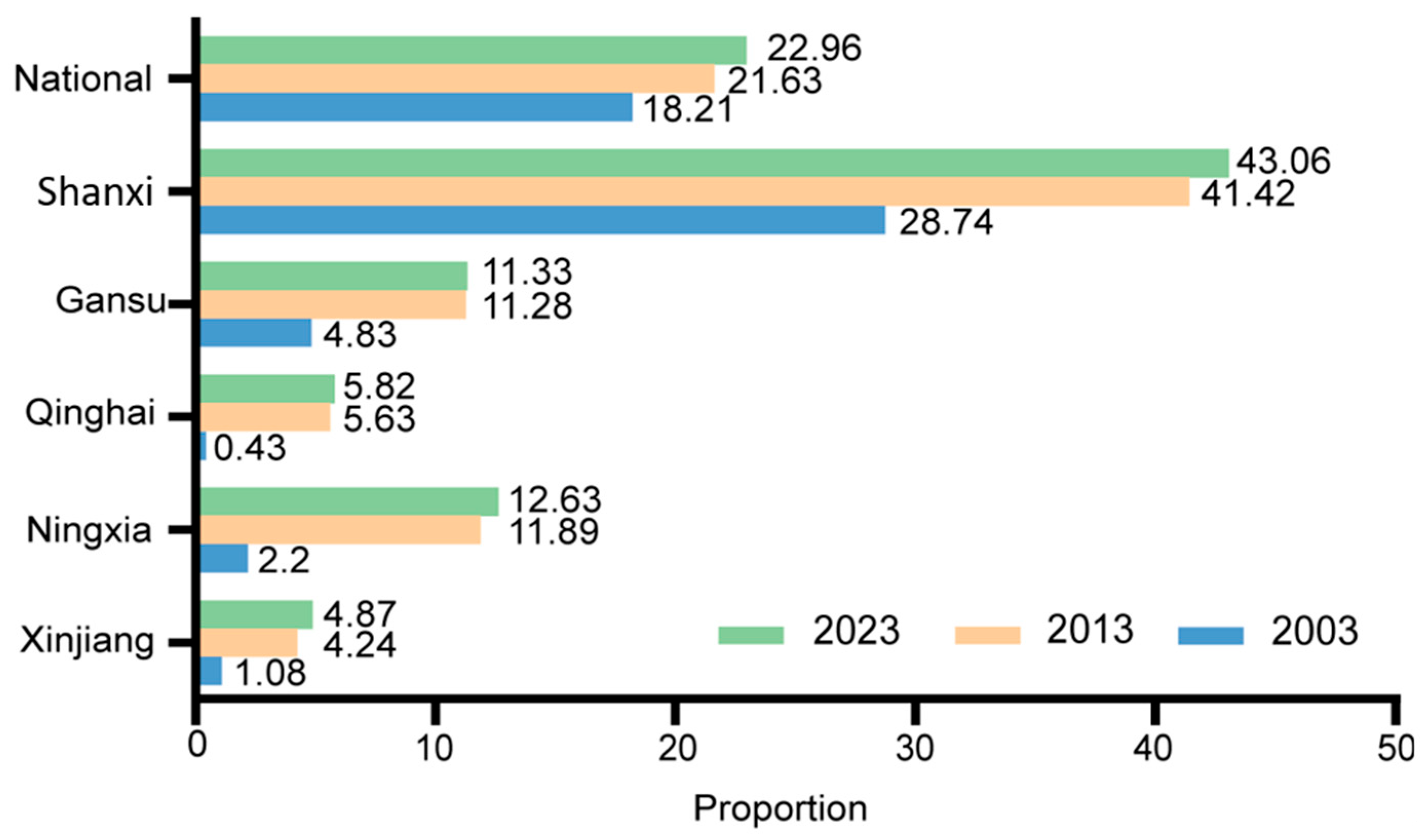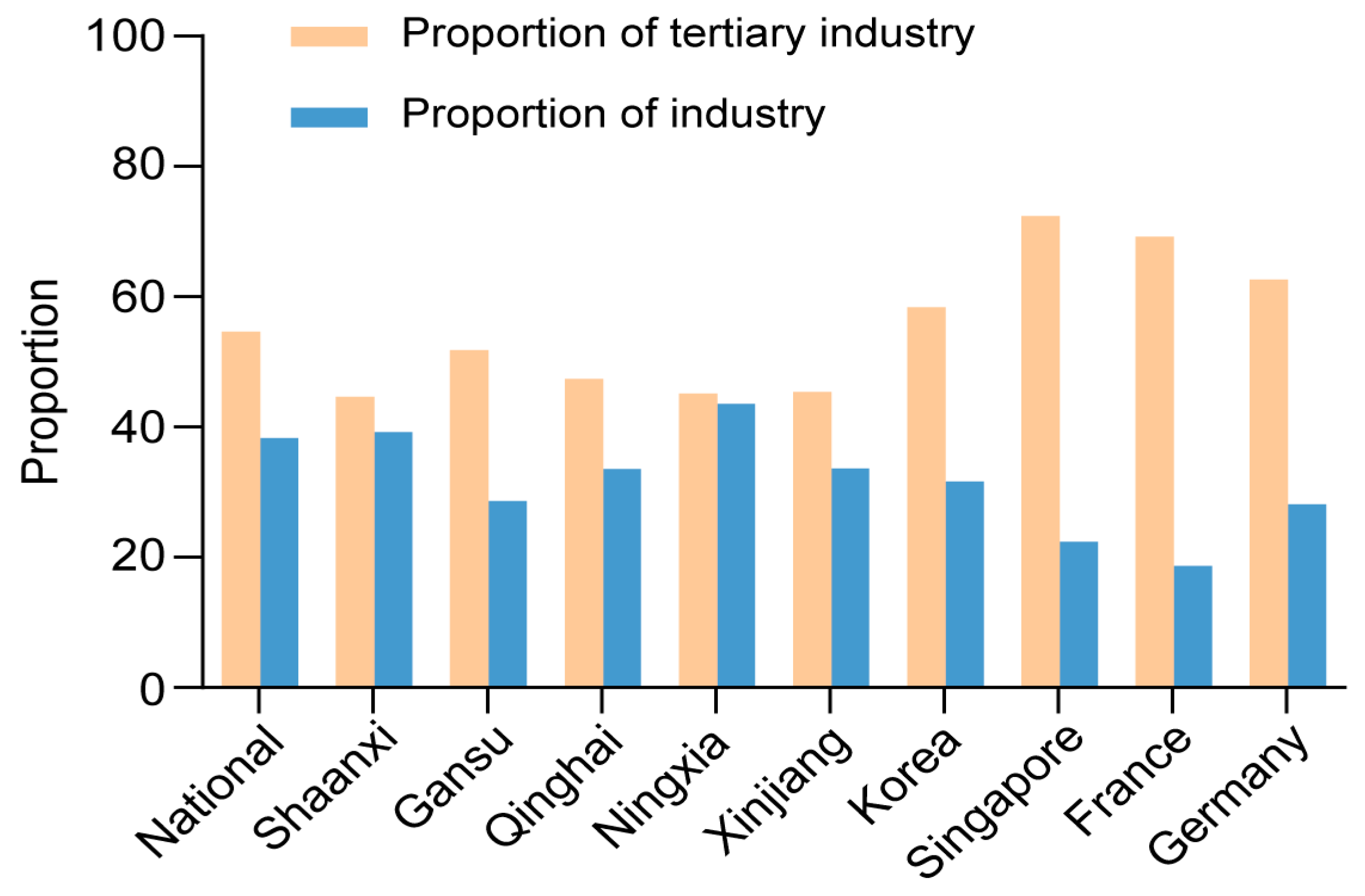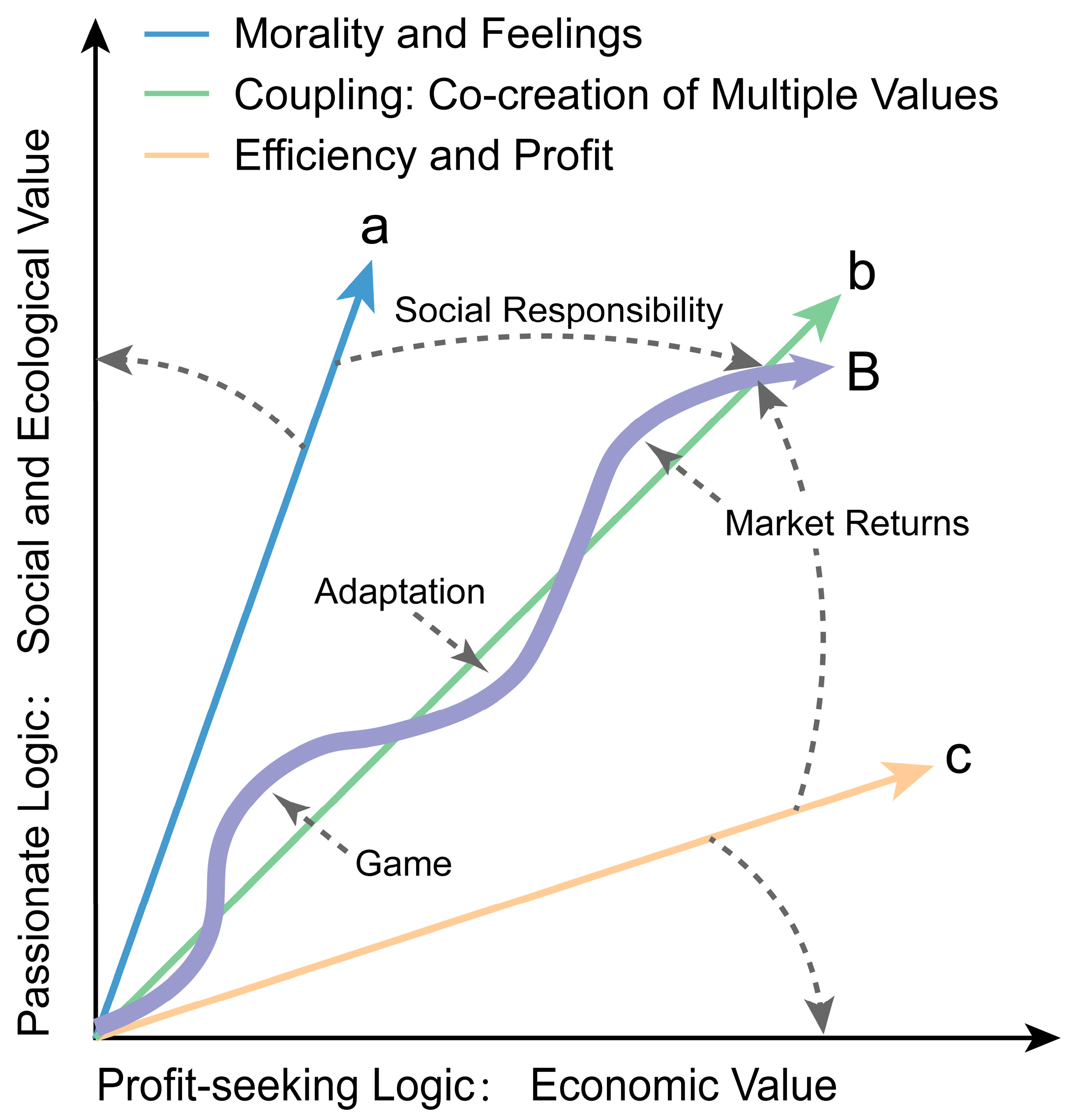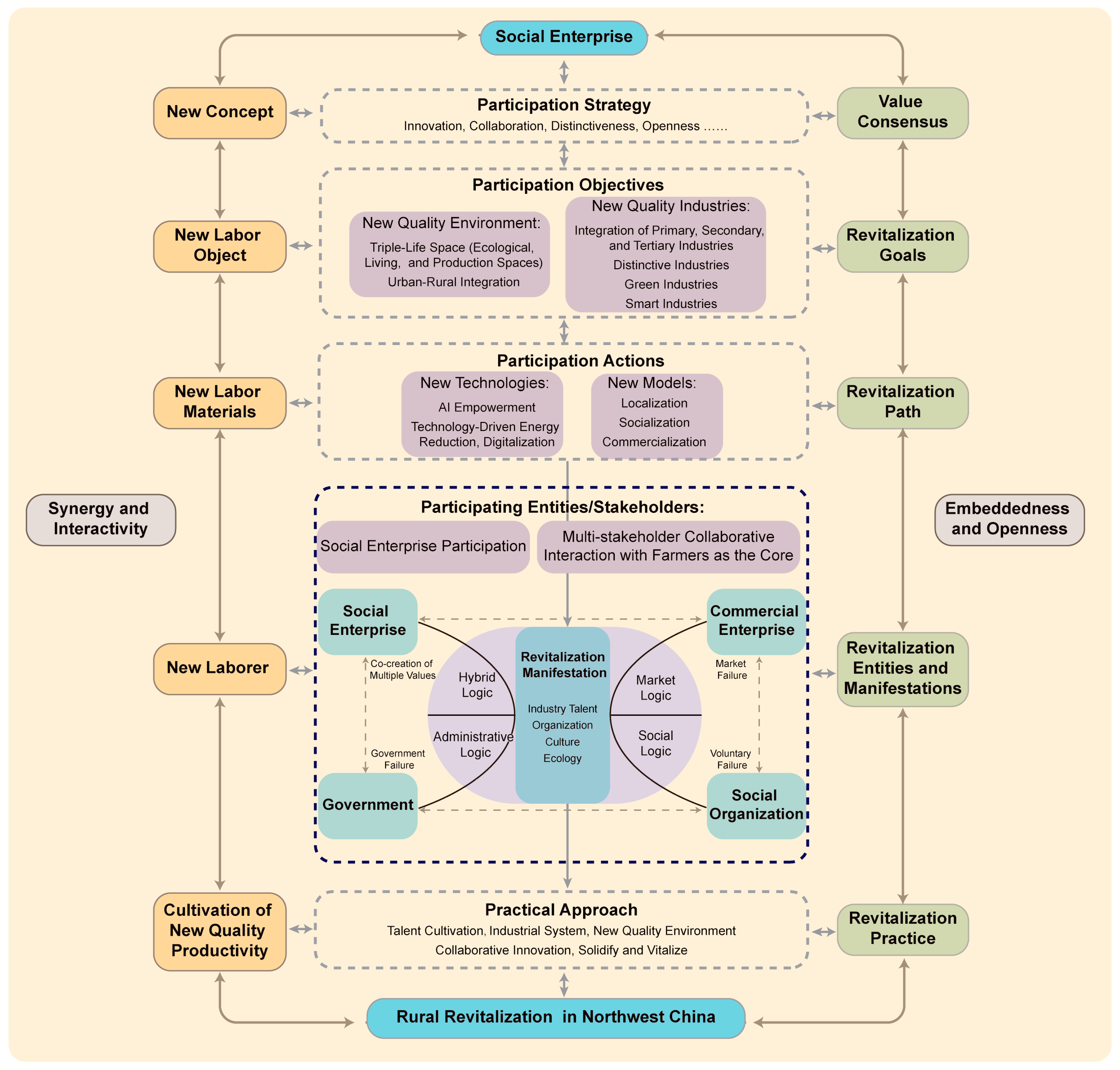Devotion vs. Profit: A Study on the Logic and Approaches of Social Enterprises’ Participation in Rural Revitalization in Northwest China from the Perspective of New Quality Productivity
Abstract
1. Introduction
2. Research Questions and Methods
2.1. Research Questions
2.1.1. A Study on Rural Revitalization in Northwest China from the Perspective of “New Quality Productive Forces”
Concept and Characteristics of “New Quality Productive Forces”
Rural Revitalization from the Perspective of “New Quality Productive Forces”
2.1.2. A Study on the Logic and Approaches for Social Enterprises to Participate in Rural Revitalization in Northwest China
Definition and Characteristics of Social Enterprises
Action Logics of Social Enterprises for Rural Revitalization
Practical Approaches of the Social Enterprises Participating in Rural Revitalization
2.2. Research Methods
2.2.1. Environmental Analysis Methods
2.2.2. Theoretical Deduction
3. Environmental Analysis
3.1. Opportunities for Social Enterprises Participating in Rural Revitalization in Northwest China
3.1.1. Intersection of Strategies
3.1.2. Abundant Energy Resources as a Base for National Export
3.1.3. Diverse Biological Species for National Biodiversity
3.1.4. Rich Cultural and Tourism Resources
3.2. Challenges Faced by Social Enterprises Participating in Rural Revitalization in Northwest China
3.2.1. Imbalance in Regional Development and Insufficient Urban–Rural Integration
3.2.2. Fragile Ecological Environment and Challenges to New Quality Rural Environment
3.2.3. Lack of Equilibrium in Industrial Structure
3.2.4. Poor Education and Severe Population Loss
3.2.5. Low R&D Investment and Challenges to Rural Technological Innovation
4. Action Logics
4.1. Profit-Seeking Logic
4.1.1. Logic of “Forerunners Helping Late-Comers” Under the Concept of Common Prosperity
4.1.2. Logic of “Resource Coordination” Under Pareto Optimality
4.2. Logic of Devotion
4.2.1. Logic of “People’s Interests First” Under the Concept of “People-Centered Development”
4.2.2. Logic of “Multi-Stakeholder Collaboration” Under the Concept of a “Community with a Shared Future”
4.2.3. Logic of “Equivalence” Under the Concept of “Urban–Rural Integration”
4.3. Co-Creation of Multi-Dimensional Value: Coupling Devotion and Profit-Seeking Logics
- If social enterprises are driven solely by the logic of devotion, in the sense of fulfilling their social responsibilities and achieving social and ecological goals (represented by Line a in Figure 3), they can address the issues of governmental and market failure in rural revitalization, but risk being afflicted with the problem of “voluntary failure.”
- If social enterprises are driven solely by profit-seeking logic, in the sense of achieving their economic goals through such means as the rich leading the poor and resource reallocation (represented by Line c in Figure 3), they may overcome “voluntary failure” but risk market failure.
5. Practical Approaches
5.1. Cultivating New Quality Talents: Supporting the Revitalization of Rural Talents Through “External Introduction + Internal Support + Sharing”
5.1.1. Cultivating Social Entrepreneurs
5.1.2. Building the Talent Engine and Organizing Four New Talent Groups to Support Rural Development
5.2. Establishing New Quality Industrial System for Rural Industrial Revitalization
5.2.1. Insisting on “Specialization” and “Integration” to Optimize Industrial Structure and Layout
Developing Distinctive Industries
Integrating the Agricultural Industry Chain into the Tertiary Industry
5.2.2. Introducing New Technologies and Ideas for Green and Efficient Production Systems
5.3. Strengthening New Quality Environments and Advancing Ecological Revitalization
5.3.1. Rebuilding Rural Production Spaces to Improve the Quality of Production and Consumption
5.3.2. Reconstructing Rural Living Spaces to Improve Residential Quality
5.3.3. Restoring Ecological Features to Improve Environmental Quality
5.4. Strengthening Technological and Cultural Collaborative Innovation: From “Conflict” to “Integration”
5.4.1. Cultural Exploration and Activation
5.4.2. Enhancing Scientific and Cultural Literacy Among Citizens
5.5. Strengthening Rural Social Enterprises Based on Hybrid Logic
5.5.1. Localizing Social Enterprises to Meet Rural Demands
5.5.2. Commercializing Social Organizations to Create Commercial Value with Social Responsibility
5.5.3. Socializing Commercial Enterprises to Create Social Value Through Commercial Approaches
5.5.4. Crossing Organizational Boundaries for Multi-Level Collaboration
Breaking Boundaries and Strengthening Collaboration Among Organizations
Strengthening the Cooperation Within the Region
Increasing Regional Cooperation to Smoothen Domestic Channels of Circulation
Open and Inclusive International Cooperation
6. Conclusions and Discussion
6.1. Research Conclusions
6.2. Research Gaps
6.3. Research Prospects
Author Contributions
Funding
Institutional Review Board Statement
Informed Consent Statement
Data Availability Statement
Acknowledgments
Conflicts of Interest
References
- Cai, S.; Gu, C.; Zhang, Z. Spatial and temporal characteristics and mechanisms of coordination between new urbanization and rural revitalization in Western China. Chin. J. Agric. Resour. Reg. Plan. 2022, 43, 202–213. [Google Scholar]
- Zhang, R.; Hu, J. Practical problems and logical approaches for the effective connection between poverty alleviation and rural revitalization. Gansu Soc. Sci. 2021, 6, 45–52. [Google Scholar]
- Vik, J.; Johnsen, J.P.; Sønvisen, S.A. The rural development trilemma. J. Rural Stud. 2025, 114, 103504. [Google Scholar] [CrossRef]
- Lv, J.; Guo, X.; Jiang, H. Rural E-Commerce and Income Inequality: Evidence from China. Sustainability 2025, 17, 4720. [Google Scholar] [CrossRef]
- Nyssens, M. Social Enterprise: At the Crossroads of Market, Public Policies and Civil Society; Routledge: Abingdon, UK, 2007. [Google Scholar]
- Park, C.; Wilding, M. An exploratory study on the potential of social enterprise to act as the institutional glue of network governance. Soc. Sci. J. 2019, 51, 120–129. [Google Scholar] [CrossRef]
- Weerawardena, J.; Mort, G.S.; Salunke, S.; Haigh, N. Editorial and research agenda: JBR special issue on business model innovation in social purpose organizations. J. Bus. Res. 2021, 125, 592–596. [Google Scholar] [CrossRef] [PubMed]
- Yue, S.; Bajuri, N.H.; Khatib, S.F.A.; Lee, Y. New quality productivity and environmental innovation: The hostile moderating roles of managerial empowerment and board centralization. J. Environ. Manag. 2024, 370, 122423. [Google Scholar] [CrossRef] [PubMed]
- Emphasized in His Inspection of Heilongjiang: Firmly Grasp the Strategic Position in the National Development Landscape and Make Efforts to Create a New High-Quality Development Framework for Heilongjiang. Available online: https://www.hlj.gov.cn/hlj/c107856/202309/c00_31666350.shtml (accessed on 9 September 2023).
- Wang, J.; Wang, Z.; Wang, H.; Chen, T. Does the new environmental protection law hinder the development of new quality productive forces in industrial enterprises? A quasi-natural experiment in China. J. Clean. Prod. 2025, 517, 145870. [Google Scholar] [CrossRef]
- Zhou, W.; He, Y. New quality productive forces: A new driving force and path for Chinese modernization. Res. Financ. Econ. Issues 2024, 4, 3–15. [Google Scholar]
- Jiang, Y.; Qiao, Z. New quality productive forces: An advanced productive force state in line with new development concepts. Southeast Acad. J. 2024, 2, 52–63+246. [Google Scholar]
- Ji, Y. Historical logic, contemporary connotation, and strategic pinnacle of new quality productive forces. New Long March 2024, 5, 47–49. [Google Scholar]
- Xu, Z.; Zheng, L.; Cheng, M. The internal logic and practical conception of new quality productive forces empowering high-quality development. Contemp. Econ. Res. 2023, 11, 51–58. [Google Scholar]
- Sheng, C. Conditions for the formation and cultivation path of new quality productive forces. Econ. Rev. J. 2024, 2, 31–40. [Google Scholar]
- Sun, S. Developing new quality productive forces: Core elements and practical directions for China’s economic modernization. Shandong Soc. Sci. 2024, 1, 22–30. [Google Scholar]
- Wang, J.; Li, Z. Mechanisms and factors of low-altitude economy’s impact on new quality productive forces—Based on financial development and corporate agglomeration. J. Hubei Univ. Econ. 2024, 22, 86–100. [Google Scholar]
- Liu, H. The mechanisms and practical Approaches of new quality productive forces empowering rural revitalization. Chongqing Soc. Sci. 2024, 9, 21–31. [Google Scholar]
- Gong, Z. Theoretical logic, practical challenges, and development Approaches of new quality productive forces empowering rural revitalization. Contemp. Rural. Financ. Econ. 2024, 4, 17–21. [Google Scholar]
- Wang, J.; Liu, R. Driving logic and Approaches of new quality productive forces in rural revitalization. J. Shenzhen Univ. (Humanit. Soc. Sci.) 2024, 41, 16–24. [Google Scholar]
- Hou, G.; Zhang, C. Comprehensive rural revitalization empowered by new quality productive forces. Res. Technol. Econ. Manag. 2024, 6, 9–14. [Google Scholar]
- Luo, L.; Chen, T.; Xu, Z. The operational mechanisms and optimization Approaches of new quality productive forces empowering rural revitalization. Acad. Exch. 2024, 7, 99–112. [Google Scholar]
- Song, Z.; Jia, M. Theoretical mechanisms and empirical tests of new quality productive forces assisting rural revitalization. J. Yunnan Agric. Univ. (Soc. Sci. Ed.) 2024, 18, 10–17. [Google Scholar]
- Gupta, P.; Srivastava, R. Research on social enterprises from an emerging economy—Systematic literature review and future research directions. J. Soc. Entrep. 2024, 15, 458–493. [Google Scholar] [CrossRef]
- Meng, Q.; Gray, M.; Bradt, L.; Roets, G. In search of strategies for rural revitalization in China: Puhan’s approach to sustainable community development. Community Dev. J. 2025, 60, 62–80. [Google Scholar] [CrossRef]
- The Non-Profit Sector in a Changing Economy, Local Economic and Employment Development (LEED). Available online: https://www.oecd.org/en/publications/the-non-profit-sector-in-a-changing-economy_9789264199545-en.html (accessed on 5 May 2003).
- Pache, A.C.; Santos, F. Inside the hybrid organization: Selective coupling as a response to competing institutional logics. J. Acad. Manag. 2013, 56, 972–1001. [Google Scholar] [CrossRef]
- Kulshrestha, R.; Sahay, A.; Sengupta, S. Constituents and drivers of mission engagement for social enterprise sustainability: A systematic review. J. Entrep. 2022, 31, 90–120. [Google Scholar] [CrossRef]
- Liu, Z.; Qiu, Z. Classification research of social enterprises: A new framework based on value drivers. Luojia Manag. Rev. 2021, 1, 1–16. [Google Scholar]
- Norbäck, M.; Zapata Campos, M.J. The market made us do it: Public procurement and collaborative labor market inclusion governance from below. Soc. Policy Adm. 2022, 56, 632–647. [Google Scholar] [CrossRef]
- Calo, F.; Sancino, A.; Scognamiglio, F. Social enterprise and social entrepreneurship in the public administration (PA) scholar field: A bibliometric analysis and some conceptual considerations. Public Manag. Rev. 2024, 26, 3013–3039. [Google Scholar] [CrossRef]
- Imanuella, S.F.; Idris, A.; Kamaruddin, N. Social entrepreneurship and rural development in post-independence Indonesia. Soc. Enterp. J. 2025, 21, 46–66. [Google Scholar] [CrossRef]
- Musinguzi, P.; Larder, N.; Baker, D. Social enterprises as a revitalization strategy for rural communities. In Rural Areas in Transition; Routledge: London, UK, 2022; pp. 127–148. [Google Scholar]
- Liu, Z.; Chen, Y. Mixed logic and cross-sector collaboration of social enterprises. Acad. Mon. 2021, 53, 85–98. [Google Scholar]
- Haugh, H.M.; Talwar, A. Linking social entrepreneurship and social change: The mediating role of empowerment. J. Bus. Ethics 2016, 133, 643–658. [Google Scholar] [CrossRef]
- Santos, F.M. A positive theory of social entrepreneurship. J. Bus. Ethics 2012, 111, 335–351. [Google Scholar] [CrossRef]
- Liu, L.; Liang, L.; Zhang, Z.; Xie, J. Service innovation of social enterprises. Sci. Technol. Manag. Res. 2016, 36, 221–226. [Google Scholar]
- Deng, G.; Cheng, Y. How social enterprises promote sustainable rural industry development: A perspective based on hybrid institutional logic. Comp. Econ. Soc. Syst. 2024, 1, 36–47. [Google Scholar]
- Zhou, Y.; Wang, Z.; Wang, W.; Wang, Y. The impact of migrant workers’ return behaviors on land transfer-in: Evidence from the China labor dynamic survey. Land 2025, 14, 869. [Google Scholar] [CrossRef]
- Liu, Z.; Qiu, Z.; Wang, S. Economic analysis and comparative transformation of social entrepreneurship—Based on the practice of rural revitalization. Fujian Trib. (Humanit. Soc. Sci.) 2020, 3, 92–104. [Google Scholar]
- Basset, F.; Giarè, F.; Senni, S.; Soriano, B. A new integrated framework to assess the impact of social farming on sustainability and rural development: A case study in Lazio. Sustainability 2025, 17, 1715. [Google Scholar] [CrossRef]
- Olmedo, L.; RinneKoski, M.K.; O’Shaughnessy, M.; Matilainen, A.; Lähdesmäki, M. Support structures for a plural economy in rural areas? Analysing the role of community-based social enterprises. Sociol. Rural. 2023, 64, 82–103. [Google Scholar] [CrossRef]
- Martens, K.; Wolff, A.; Hanisch, M. Understanding social innovation processes in rural areas: Empirical evidence from social enterprises in Germany. Soc. Enterp. J. 2020, 17, 220–239. [Google Scholar] [CrossRef]
- Wang, Q.; Dang, X.; Song, T.; Xiao, G.; Lu, Y. Agro-tourism integration and county-level sustainability: Mechanisms and regional heterogeneity in China. Sustainability 2025, 17, 4549. [Google Scholar] [CrossRef]
- Han, G.; Wei, Z.; Zheng, H.; Zhu, L. Evaluation index system of rural ecological revitalization in China: A national empirical study based on the driver-pressure-state-impact-response framework. Land 2024, 13, 1270. [Google Scholar] [CrossRef]
- Battilana, J.; Lee, M. Advancing research on Hybrid organizing: Insights from the study of social enterprises. Acad. Manag. Ann. 2014, 8, 397–441. [Google Scholar] [CrossRef]
- Social Enterprise Policy Needs to ‘Step Out of the Circle’. Available online: http://www.gongyishibao.com/html/renwuguandian/2024/11/28899.html (accessed on 11 November 2024).
- Luo, C.P.; Huang, J.; Zhang, W. Western development, urban-rural integration and new urbanization: A review of the 10th Academic Annual Conference of China Western Development Research Association (2015). Manag. World 2015, 8, 4. [Google Scholar] [CrossRef]
- Xiao, D.; Zhu, Y. Participation of social enterprises in rural community asset building: The case of the “e-Farm Plan”. China Nonprofit Rev. 2022, 29, 203–219. [Google Scholar]
- Communiqué on National Expenditures on Science and Technology in 2023. Available online: https://www.stats.gov.cn/english/PressRelease/202410/t20241014_1956904.html (accessed on 2 October 2024).
- Friedland, R.; Alford, R.R. Bringing society back in: Symbols, practices and institutional contredictions. In The New Institutinalism in Organizational Analysis; Powell, W., Dimaggio, P., Eds.; University of Chicago Press: Chicago, IL, USA, 1991; pp. 232–263. [Google Scholar]
- Klitsie, E.J.; Ansari, S.; Volberda, H.W. Maintenance of cross-sector partnerships: The role of frames in sustained collaboration. J. Bus. Ethics 2018, 150, 401–423. [Google Scholar] [CrossRef] [PubMed]
- Ma, Y.; Lü, J. Research on the coupled and coordinated development of new urbanization and rural revitalization: The case of Gansu Province. Xinjiang State Farms Econ. 2020, 6, 15–23+32. [Google Scholar]
- Jin, B. Mechanisms of social enterprises and insights into understanding modern market economies. China Ind. Econ. 2022, 3, 5–19. [Google Scholar]
- Miao, Q.; Zhao, Y. How do social enterprises participate in social governance? A case study in the environmental field and its implications. Southeast Acad. J. 2020, 6, 130–139. [Google Scholar]
- Jiang, C. The course, experience, and implications of optimizing urban-rural relations governance in the century-long history of the communist party of China. J. Humanit. 2021, 11, 1–12. [Google Scholar]
- Wen, T. Ecological civilization transition and social enterprise heritage in China. J. China Agric. Univ. (Soc. Sci. Ed.) 2019, 36, 111–117. [Google Scholar]
- Shen, K.; Cheng, G.; Zhao, Q. Enhancing new driving forces for high-quality development with new quality productive forces. Acad. Res. 2024, 4, 87–93+177–178. [Google Scholar]
- Barney, B. Firm resources and sustained competitive advantage. J. Manag. 1991, 17, 99–120. [Google Scholar] [CrossRef]
- Teece, D.J.; Pisano, G.; Shuen, A. Dynamic capabilities and strategic management. Strateg. Manag. J. 1997, 18, 509–533. [Google Scholar] [CrossRef]
- Drucker, P.F. The Practice of Management; Harper & Row: New York, NY, USA, 1954. [Google Scholar]
- Young, D. Entrepreneurship and the Behavior of Non-Profit Organizations: Elements of Theory. In The Economics of Non-Profit Institutions; Rose-Ackerman, S., Ed.; Oxford University Press: New York, NY, USA, 1986. [Google Scholar]
- Wang, Z. Forging ‘new farmers’ to activate new momentum: Baoji Qishan County’s ‘integrated learning and application’ talent cultivation model. Farmers Daily, 1 August 2025; p. 6. [Google Scholar]
- Yang, L.; Ning, W. Mechanisms and effects of the sustainable integration of digital-driven rural cultural tourism from the perspective of symbiosis. Sustain. Futures 2025, 10, 100867. [Google Scholar] [CrossRef]
- Wang, S. Commercialization of non-profit organizations and their transformation into non-profit social enterprises. China Soc. Organ. Res. 2013, 6, 31–45. [Google Scholar]
- Xiao, H.; Zhang, Z.; Wang, X. Realization mechanisms of social value co-creation by digital platform enterprises: A case study of Meituan’s “Green Mountain Project”. Manag. World 2024, 40, 146–171. [Google Scholar]
- Chavez, G.C.; Gruber, S.; Schubert, T. How do intra-and inter-organisational collaboration affect research performance? Evidence from German universities. J. Informetr. 2025, 19, 101675. [Google Scholar] [CrossRef]




| Regions | R&D Investment (CNY 100 million) | R&D Investment Intensity (%) |
|---|---|---|
| National | 33,357.1 | 2.65 |
| Shanxi | 846 | 2.5 |
| Gansu | 156.2 | 1.32 |
| Qinghai | 30.3 | 0.8 |
| Ningxia | 85.5 | 1.61 |
| Xinjiang | 115.5 | 0.6 |
Disclaimer/Publisher’s Note: The statements, opinions and data contained in all publications are solely those of the individual author(s) and contributor(s) and not of MDPI and/or the editor(s). MDPI and/or the editor(s) disclaim responsibility for any injury to people or property resulting from any ideas, methods, instructions or products referred to in the content. |
© 2025 by the authors. Licensee MDPI, Basel, Switzerland. This article is an open access article distributed under the terms and conditions of the Creative Commons Attribution (CC BY) license (https://creativecommons.org/licenses/by/4.0/).
Share and Cite
Wang, X.; Li, J.; Fu, C. Devotion vs. Profit: A Study on the Logic and Approaches of Social Enterprises’ Participation in Rural Revitalization in Northwest China from the Perspective of New Quality Productivity. Sustainability 2025, 17, 7389. https://doi.org/10.3390/su17167389
Wang X, Li J, Fu C. Devotion vs. Profit: A Study on the Logic and Approaches of Social Enterprises’ Participation in Rural Revitalization in Northwest China from the Perspective of New Quality Productivity. Sustainability. 2025; 17(16):7389. https://doi.org/10.3390/su17167389
Chicago/Turabian StyleWang, Xiaowen, Jimin Li, and Chunxiang Fu. 2025. "Devotion vs. Profit: A Study on the Logic and Approaches of Social Enterprises’ Participation in Rural Revitalization in Northwest China from the Perspective of New Quality Productivity" Sustainability 17, no. 16: 7389. https://doi.org/10.3390/su17167389
APA StyleWang, X., Li, J., & Fu, C. (2025). Devotion vs. Profit: A Study on the Logic and Approaches of Social Enterprises’ Participation in Rural Revitalization in Northwest China from the Perspective of New Quality Productivity. Sustainability, 17(16), 7389. https://doi.org/10.3390/su17167389






